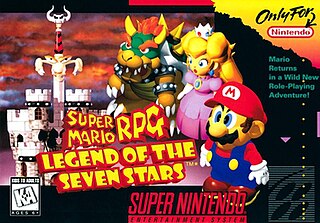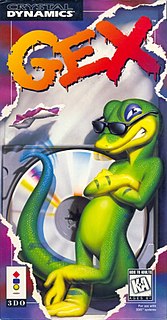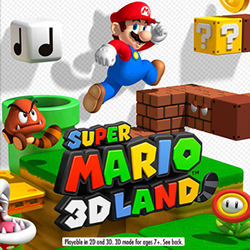
The Nintendo 64 (abbreviated as N64, stylized as NINTENDO64) is a home video game console developed and marketed by Nintendo. It was first released on June 24, 1996 in Japan, September 29, 1996 in North America, and March 1, 1997 in Europe and Australia. It was the last major home console to use cartridges as its primary storage format until the Nintendo Switch in 2017. As a fifth generation console, it competed primarily with the PlayStation and the Sega Saturn.

Platform games are a video game genre and subgenre of action games in which the core objective is to move the player character between points in a rendered environment. Platformers are characterized by their level of use in jumping and climbing to navigate the player's environment and reach their goal. Levels and environments feature uneven terrain and suspended platforms of varying height that requires use of the player character's abilities in order to traverse. Other acrobatic maneuvers factor into the gameplay as well, such as climbing, swinging from objects such as vines or grappling hooks, jumping off walls, air dashing, gliding through the air, being shot from cannons or bouncing from springboards or trampolines. Games where jumping is automated completely, such as 3D games in The Legend of Zelda series, fall outside of the genre.

Mario Kart 64 is a 1996 kart racing video game developed and published by Nintendo for the Nintendo 64. It is the successor to Super Mario Kart for the Super Nintendo Entertainment System, and the second game in the Mario Kart series. It was released in Japan in December 1996, in North America in February 1997 and in the U.K. in June 1997. It was later released as a Virtual Console game for the Wii and Wii U in 2007 and 2016, respectively.

Super Mario World 2: Yoshi's Island is a 1995 platform game developed and published by Nintendo for the Super Nintendo Entertainment System (SNES). To reunite baby Mario with his brother Luigi, who has been kidnapped by Kamek, the player controls Yoshi, a friendly dinosaur, through 48 levels while carrying Baby Mario. As a Super Mario series platformer, Yoshi runs and jumps to reach the end of the level while solving puzzles and collecting items. In a style new to the series, the game has a hand-drawn aesthetic and is the first to have Yoshi as its main character. The game introduces his signature abilities to flutter jump and produce eggs from swallowed enemies.

Super Mario RPG: Legend of the Seven Stars is a role-playing video game developed by Square and published by Nintendo for the Super Nintendo Entertainment System in 1996. It was the final Mario game published for the SNES. The game was directed by Chihiro Fujioka and Yoshihiko Maekawa, produced by Mario creator Shigeru Miyamoto, and scored by Yoko Shimomura.

Paper Mario is a role-playing video game developed by Intelligent Systems and published by Nintendo for the Nintendo 64 home video game console. Paper Mario is the first game in the Paper Mario series. First released in Japan in 2000 and then internationally in 2001, Paper Mario was later re-released for Nintendo's Wii Virtual Console in July 2007 and Wii U Virtual Console in 2015.

Super Mario 64 is a 1996 platform game for the Nintendo 64 and the first Super Mario game to feature 3D gameplay. It was developed by Nintendo EAD and published by Nintendo. As Mario, the player collects power stars while exploring Princess Peach's castle and must rescue her from Bowser. Super Mario 64 features open-world playability, degrees of freedom through all three axes in space, and relatively large areas which are composed primarily of true 3D polygons as opposed to only two-dimensional (2D) sprites. It emphasizes exploration within vast worlds, which require the player to complete various missions in addition to the occasional linear obstacle courses. It preserves many gameplay elements and characters of earlier Mario games as well as the visual style.

Donkey Kong Country is a 1994 platform game developed by Rare and published by Nintendo for the Super Nintendo Entertainment System (SNES). It is a reboot of Nintendo's Donkey Kong franchise and follows the gorilla Donkey Kong and his nephew Diddy Kong as they set out to recover their stolen banana hoard from King K. Rool and the Kremlings. In 40 side-scrolling levels, the player collects items, defeats enemies and bosses, and finds secrets on their journey to defeat K. Rool. In the multiplayer modes, two players can work together cooperatively or race each other.

Mario's Time Machine is an educational video game originally released for MS-DOS and then for the Nintendo Entertainment System and Super NES consoles. The Software Toolworks both developed and published the MS-DOS and Super NES versions in 1993, while the NES version was developed by Radical Entertainment and published by The Software Toolworks in 1994. The MS-DOS version was re-released as Mario's Time Machine Deluxe in 1996.

Mischief Makers, released in Japan as Yuke-Yuke!! Trouble Makers is a 1997 side-scrolling platform video game developed by Treasure and published by Enix and Nintendo for the Nintendo 64. The player assumes the role of Marina, a robotic maid who journeys to rescue her creator from the emperor of Planet Clancer. The gameplay revolves around grabbing, shaking, and throwing objects. There are five worlds and 52 levels, and the game is displayed in 2.5D.

Jumping Flash! is a first-person platform video game co-developed by Exact and Ultra and published by Sony Computer Entertainment. The first installment in the Jumping Flash! series, it was first released for the PlayStation on 28 April 1995 in Japan, 29 September in Europe and 1 November in North America. It was re-released through the PlayStation Network store on PlayStation 3 and PlayStation Portable in 2007.

Croc: Legend of the Gobbos is a platform game developed by Argonaut Games and published by Fox Interactive. The game was an early example of a 3D platform game, being released in North America in September 1997 for the Sony PlayStation, and later on that year for the Sega Saturn and Microsoft Windows. Taking place in the fictional setting of the Gobbo Valley, Croc: Legend of the Gobbos follows a young crocodile named Croc, who sets out to rescue a group of furry creatures known as Gobbos from the evil magician Baron Dante.

Mickey Mania: The Timeless Adventures of Mickey Mouse is a 1994 platform video game developed by Traveller's Tales and published by Sony Imagesoft for the Super Nintendo Entertainment System, Sega Genesis, and Sega CD. In the game, the player controls Mickey Mouse, who must navigate through various side-scrolling levels, each designed and based from classical Mickey Mouse cartoons. The game was later released on the PlayStation in 1996 as Mickey's Wild Adventure. A sequel, Mickey Mania 2, was planned but never released.

M.C. Kids is a 1992 platform video game developed and published by Virgin Interactive. It was initially released for the Nintendo Entertainment System in February 1992 in North America, and by Ocean Software in May 1993 in Europe. As a licensed product for the McDonald's fast food restaurant chain, the game stars two children named Mack and Mick who venture into the fantasy world of McDonaldland in order to return Ronald McDonald's magical bag which has been stolen by the Hamburglar. The game was created by four people in eight months: Darren Bartlett Gregg Iz-Tavares and Dan Chang (programming) and Charles Deenen (audio).

Bubsy 3D is a platform game developed by Eidetic and published by Accolade. It is the first 3D game in the Bubsy series, and the fourth game in the series overall. The game was released for the PlayStation on November 25, 1996 in North America, with a later European release in August 1997. Bubsy 3D follows the series titular character, an orange bobcat named Bubsy, who travels to the planet Rayon to stop the alien Woolies, and return safely to Earth.

Super Mario Galaxy is a 2007 platform action-adventure video game developed and published by Nintendo for the Wii. It is the third 3D game in the Super Mario series. As Mario or Luigi, the player embarks on a quest to rescue Princess Peach, save the universe from Bowser, and collect 121 Power Stars. The levels in the game consist of galaxies filled with minor planets and worlds, with different variations of gravity, the central element of gameplay. The player character is controlled using the Wii Remote and Nunchuk, and completes missions, fights bosses, and reaches certain areas to collect Power Stars. Certain levels use the motion-based Wii Remote functions.

Super Mario is a platform game series created by Nintendo, featuring their mascot, Mario. Alternatively called the Super Mario Bros. series or simply the Mario series, it is the central series of the greater Mario franchise. At least one Super Mario game has been released for every major Nintendo video game console. There have also been a number of Super Mario video games released on non-Nintendo gaming platforms. There are currently twenty-one similar games and one cross-series game that may or may not be included as part of the series.

Gex is a platform game developed by Crystal Dynamics. It was originally released for the 3DO in 1995; ports of the game for the PlayStation and Sega Saturn were later developed by Beam Software, and a PC version was licensed by Microsoft and released for Microsoft Windows. It was a pack-in game for Panasonic models of the 3DO later in the console's life. It is the first in the Gex series of video games, and introduces players to the title character, a wisecracking, television-obsessed gecko voiced by comedian Dana Gould, who must venture through the "Media Dimension" and defeat Rez, the overlord of the dimension who wants to make Gex into his new network mascot.

Super Mario 3D Land is a platform video game in the Super Mario series developed and published by Nintendo for their Nintendo 3DS handheld game console. It was released worldwide in November 2011, beginning in Japan. It was the first Mario game to be released for the 3DS.


















